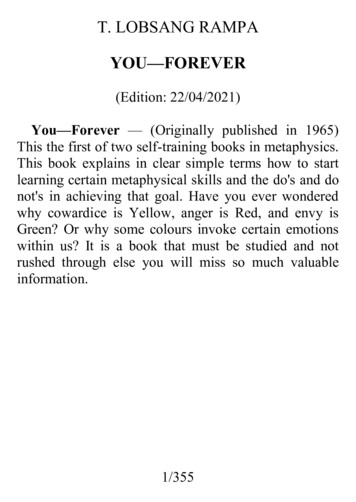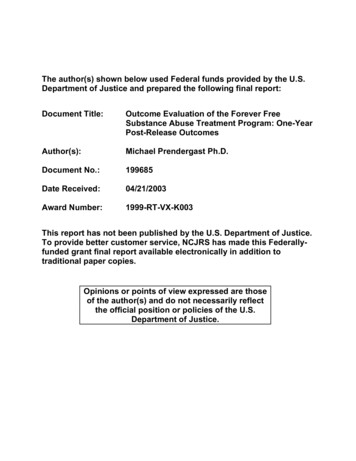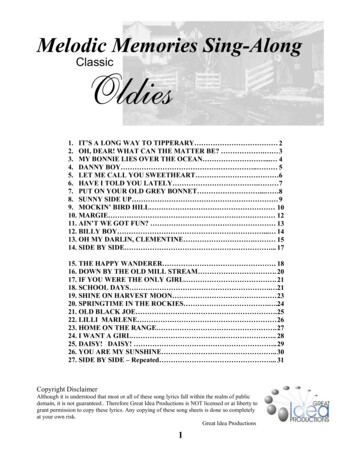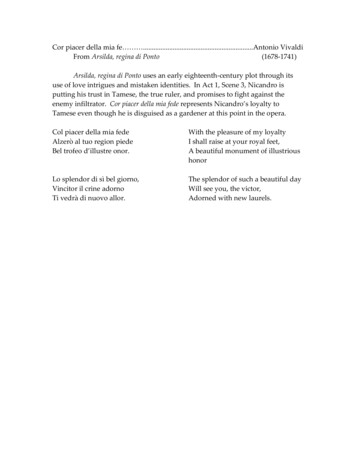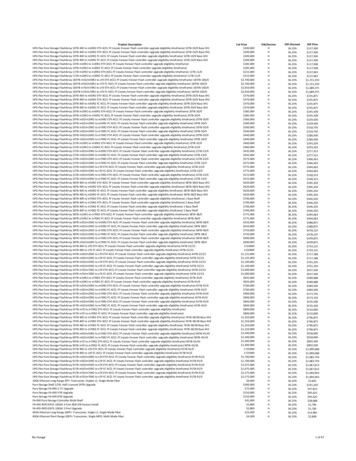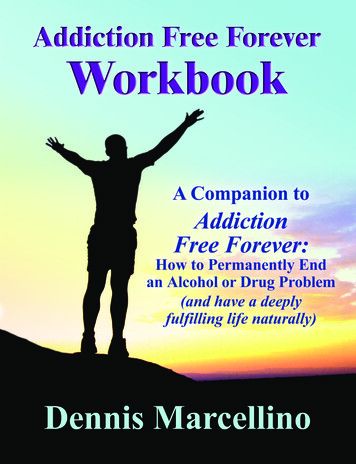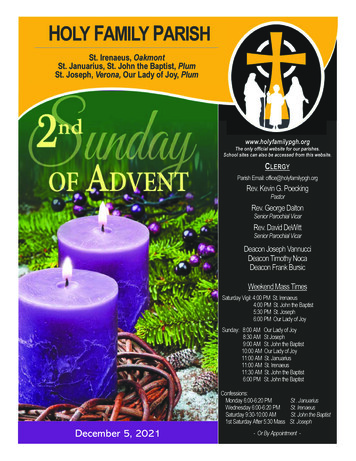
Transcription
How Long is Forever This Time? The BrokenPromise of Bankruptcy TrustsS. TODD BROWN†INTRODUCTIONImagine a Medicare system in which the medicalproviders that submit the most reimbursement claimsdetermine the criteria for reimbursement, have the power toveto any plan for auditing the claims they submit, andeffectively control the appointment of those responsible foroverseeing reimbursements and audits. Would claimcriteria be designed to strike an optimal balance betweenexcluding specious claims and managing administrativecosts, or would the criteria focus on making the processmost efficient for medical providers? Would we see morerobust audits, or would they largely abandon claim audits?The preceding hypothetical mirrors the manner inwhich bankruptcy trusts are established. Section 524(g) ofthe Bankruptcy Code authorizes the entry of an injunctionthat channels all of a debtor’s asbestos-related liabilities toa bankruptcy trust, which is established by the debtor topay all valid current and future asbestos claims. Due to anoversight in the design of section 524(g), however, currentclaimants enjoy the power to veto any plan.1 Given thispower, the lawyers who speak for the largest blocks ofcurrent claimants have the power to dictate trust claim† Associate Professor, SUNY Buffalo Law School. The Author wishes to thankChristine Bartholomew, Mark Behrens, Kirk Hartley, Peter Kelso, StuartLazar, Chris Pashler, Marc Scarcella, Jack Schlegel, and Jim Wooten for theirinsight and input concerning this project. Special thanks to my researchassistant, Logan Geen, for his assistance in this project. Any errors oromissions, of course, are the author's own.1. As is more fully outlined in Parts I.B.3 and II, this veto power stems fromthe requirement that at least 75% of current claimants vote in favor of the planin order for the channeling injunction to be issued. S. Todd Brown, Section524(g) Without Compromise: Voting Rights and the Asbestos BankruptcyParadox, 2008 COLUM. BUS. L. REV. 841, 855-64, 902-04 (2008) (explaining howthe design of section 524(g) provides lead plaintiffs’ counsel with an unassailableveto power over asbestos bankruptcy cases).537
538BUFFALO LAW REVIEW[Vol. 61qualification criteria and settlement values, control keyappointments, and structure trust governance provisions topreserve their influence over the trusts post-confirmation.2The danger in this design is that current claimants willinsist upon relaxed standards and inflated payments fortheir own claims and leave little for unknown future victims.3 Ensuring equality of distribution to all claimants whoare bound by the plan of reorganization—current and future—is both a “‘central policy of the Bankruptcy Code’”generally4 and the “central purpose”5 of section 524(g) specifically. To that end, section 524(g) requires the appointment of an independent legal representative for future victims.6 Moreover, in order to issue the channeling injunction,the district court must first determine that the injunction is“fair and equitable” to future victims7 and that the trustwill “value, and be in a financial position to pay, presentclaims and future demands that involve similar claims insubstantially the same manner.”8Notwithstanding the statutory protections for futurevictims, the available public data shows that few trusts thathave processed their initial claims remain in position toensure equitable payments to future victims. Paymentsfrom the most recently established trusts declined as much2. See infra notes 99-100 and accompanying text.3. As the Third Circuit recently observed, “the trusts place the authority toadjudicate claims in private rather than public hands, a difference that has attimes given us and others pause, since it endows potentially interested partieswith considerable authority.” In re Federal-Mogul Global Inc., 684 F.3d 355, 362(3d Cir. 2012).4. In re W.R. Grace & Co., 475 B.R. 34, 120-21 (Bankr. D. Del. 2012)(quoting In re Combustion Eng’g Inc., 391 F.3d 190, 239 (3d Cir. 2004)) (“Thisemphasis on the equality of distribution among creditors is highlighted withinthe requirements of 11 U.S.C. §§ 524(g) and 1123(a)(4) of the Code.”).5. In re Plant Insulation Co., 469 B.R. 843, 860 (Bankr. N.D. Cal. 2012)(“The central purpose of section 524(g) is the equal treatment of present andfuture asbestos claims. This policy is enunciated clearly in both the languageand legislative history of the statute.”).6. 11 U.S.C. § 524(g)(4)(B)(i) (2006).7. 11 U.S.C. § 524(g)(4)(B)(ii).8. 11 U.S.C. § 524(g)(2)(B)(ii)(V).
2013]BANKRUPTCY TRUSTS539as 90% following the initial claim processing period,9 andthe median payment percentage10 across the trusts surveyedfor this paper has reached an all-time low of 14%.11 Roughlytwo-thirds of the trusts have reduced payments to claimantsat least once since 2010, resulting in per-claim paymentreductions of up to 93.33% in that time.12 In sum, althoughtrusts are established on the promise to pay all current andfuture victims equitably, this promise has already beenbroken at all but a few trusts.The threat to future victims has become pressing giventhe dramatic growth of the bankruptcy trust system. Todate, nearly sixty bankruptcy trusts have been establishedor are in the process of being established.13 These trustsdistributed more than 14 billion to claimants from 2006through 2011, leaving only 18 billion in assets14 to satisfythe claims submitted to them over the next four decades.159. See Notice to Holders of TDP Determined Lummus Asbestos PI lummustrust.org/Files/20110616 Lummus Letter To TDP ClaiC Holders.pdf (reducing payment percentage from 100% for claims processedthrough August 2, 2010, to 10% for newly filed claims).10. The payment percentage is the amount of a claim’s assigned value that isactually paid by the trust. See discussion infra Part I.C.2.11. See infra Appendix A (Payment Percentages).12. Id. (twenty-two of the thirty-two trusts included in the study paying athistoric lows). One trust that has not reduced its initial payment percentage,Combustion Engineering, was the product of a pre-packaged bankruptcysettlement that overtly front-loaded payments pursuant to a two-tier trust. Seeinfra notes 196-97 and accompanying text. If these payments are taken intoaccount, twenty-three of the thirty-two trusts studied are currently payingclaims at historically low levels.13. U.S. GOV’T ACCOUNTABILITY OFFICE, ASBESTOS INJURY COMPENSATION: THEROLE AND ADMINISTRATION OF ASBESTOS TRUSTS 3 (2011) [hereinafter GAOREPORT].14. Marc C. Scarcella & Peter R. Kelso, Asbestos Bankruptcy Trusts: A 2012Overview of Trust Assets, Compensation & Governance, MEALEY’S ASBESTOSBANKR. REP., June 2012, at 1, 2. This amount excludes the roughly 12 billionset aside for trusts that have not yet become active. Id.15. See AM. ACAD. ACTUARIES, CURRENT ISSUES IN ASBESTOS LITIGATION 2(2006) (“Although occupational exposure to asbestos was significantly reducedfollowing the establishment of Occupational Safety and Health Administration(OSHA) requirements in the early 1970s, asbestos diseases are expected tomanifest at least through 2050 in the United States, and longer in several othercountries where high exposure levels continued longer.”).
540BUFFALO LAW REVIEW[Vol. 61As more defendants leave the tort system and establishbankruptcy trusts, future victims will increasingly look tothe trust system for payment. If current trends andpractices hold, however, bankruptcy trusts will pay futurevictims a fraction of the amount paid to initial trustclaimants.This Article addresses some of the reasons for this failure and outlines measures for improving trust governanceand performance. Part I provides a basic summary of process for establishing a bankruptcy trust under section 524(g)and an overview of features common across the trusts. PartII outlines the misalignment of private incentives and thepolicy objectives of section 524(g) and identifies specific resulting weaknesses in trust criteria and quality controls.Part III analyzes the extent to which the prevailing trustmodel undermines future victims’ interests, some commondefenses of the bankruptcy trust system, and whether future trusts that follow the same model can be confirmed asconsistent with the dictates of due process and the expressterms of section 524(g). Part IV advances a model forstreamlining and improving oversight of bankruptcy trustsubmissions and payments, which, in turn, should betterprotect future victims’ interests in existing and futuretrusts.I. THE ORIGIN, PURPOSE, AND STRUCTURE OF BANKRUPTCYTRUSTSA. The Objectives of the Bankruptcy Trust SystemThe twin objectives of bankruptcy law—maximizing thepool of assets available for distribution to creditors andensuring that this distribution is equitable—are reflected inevery Anglo-American bankruptcy law dating back to theStatute of Elizabeth.16 Even the decision to place theexclusive power to adopt a uniform national bankruptcy lawwith the federal government through the BankruptcyClause had its origins in the fear that individual stateswould pass laws allowing inequitable discharges anddistributions that favored their citizens ahead of the16. 1571, 13 Eliz., c. 5, § 1 (Eng.) (prohibiting transfers made with the“[i]ntent to delaye hynder or defraude Creditors and others of theyr juste andlawfull Actions”).
2013]BANKRUPTCY TRUSTS541citizens of other states.17 The substantive provisions of themodern Bankruptcy Code—including the automatic stay,the power to avoid preferences and fraudulent conveyances,and the absolute priority rule—work collectively tomaximize assets and ensure equitable distributions tocreditors.Procedurally, federal bankruptcy law advances theseobjectives by empowering creditors to protect theirinterests, both individually and collectively, no matter howlarge or small their individual stakes in the case. Allcreditors have the right to object to proposals that affecttheir interests18 and vote on any proposed reorganizationplan.19 The Bankruptcy Code also contemplates independentappointments of trustees, examiners and official creditorcommittees to protect the interests of all creditors againstencroachment by repeat players and more influentialcreditors.20This procedural design works relatively well in thetypical Chapter 11 corporate restructuring of the debtor’scurrent assets and liabilities. What if the ability toreorganize hinges upon the debtor’s ability to address theclaims of not only current creditors but also currentlyunknowable future creditors? These creditors cannot receivesufficient notice to satisfy due process,21 and it is unlikelythat their interests will be fairly represented by other17. See, e.g., JOSEPH STORY, COMMENTARIES ON THE p://www.lonang.com/exlibris/story/sto-316.htm.OF THEat18. 11 U.S.C. § 1109(b) (2006).19. 11 U.S.C. § 1126(a).20. See 11 U.S.C. §§ 1102-1106.21. With the Third Circuit’s recent rejection of Avellino & Bienes v. M.Frenville Co. (In re M. Frenville Co.), 744 F.2d 332 (3d Cir. 1984), it appearswell settled that asbestos personal injury claims qualify as “‘claims’” subject todischarge under the Bankruptcy Code. Jeld-Wen, Inc. v. Van Brunt (In reGrossman’s Inc.), 607 F.3d 114, 120-21 (3d Cir. 2010) (en banc). Nonetheless,claims may be discharged in bankruptcy only to the extent consistent with dueprocess, and victims that have no reason to be aware of their potential asbestospersonal injury claims against a debtor are unlikely to have a sufficientlycolorable claim at the time of discharge or knowledge of the need to protect theirinterests to satisfy due process. Id. at 127-28.
542BUFFALO LAW REVIEW[Vol. 61parties to the case.22 Yet forcing the debtor intoliquidation—as may be required if these future creditors’claims cannot be discharged in the reorganization plan—may ensure that they will receive nothing from thebankruptcy estate.23The bankruptcy trust model was adopted in the firstasbestos bankruptcies to resolve this problem. This modelincluded features that provided courts with a basis forbinding future victims notwithstanding their absence and toprotect them from overreaching by other parties ininterest.24 Consistent with other proceedings in whichinterested parties are unable to speak on their own behalf,courts appointed legal representatives to speak for futurevictims.25 These representatives assisted current parties ininterest in the negotiation of the debtors’ reorganizationplans, which included the establishment of bankruptcytrusts funded by the debtors’ securities, insurancerecoveries, and other assets.26 To ensure that the debtors22. In re Amatex Corp., 755 F.2d 1034, 1042-43 (3d Cir. 1985) (discussingfuture claimants’ conflicting interests with the debtor and current asbestoscreditors). Similar concerns about the inherent conflicts of interests betweencurrent and future victims animated the Supreme Court’s rejection of asbestosclass action settlements. Ortiz v. Fibreboard Corp., 527 U.S. 815, 856 (1999);Amchem Prods., Inc. v. Windsor, 521 U.S. 591, 626 (1997).23. See In re Plant Insulation Co., 469 B.R. 843, 852-53 (Bankr. N.D. Cal.2012). This concern is reflected in Judge Lifland’s analysis of the due processquestion in the Johns-Manville bankruptcy:Finally, it is worthwhile to remember who due process will serve in thisreorganization. The goal of the Plan and the purpose of the Injunctionis to preserve the rights and remedies of those parties, who by anaccident of their disease cannot even speak in their own interest. Theimpracticable, if not impossible version of due process envisioned by theObjectors would effectively destroy these rights and remedies. Theoriesand standards of “due process” are nothing more than the human effortto make the inchoate notions of justice and equity real and tangible toparties who stand before a court of law. The Objectors’ “due process”,which would deny asbestos victims justice and equity, is not a “dueprocess” at all.In re Johns-Manville Corp., 68 B.R. 618, 627 (Bankr. S.D.N.Y. 1986).24. See Brown, supra note 1, at 896-97.25. See Frederick Tung, The Future Claims Representative in Mass TortBankruptcy: A Preliminary Inquiry, 3 CHAP. L. REV. 43, 72 (2000).26. See id.
2013]BANKRUPTCY TRUSTS543could satisfy the requirements for confirmation,27 the courtsissued permanent injunctions channeling all future tortclaims against the debtor to the trusts.28 Although thisprocess was controversial, it reflected a pragmaticexpansion of the basic principles of Chapter 11 generally—preservation of the going concern value of the debtor andequitable distribution to creditors with similar rights—toinclude future asbestos personal injury victims.An immediate problem with this approach was itsuncertain foundations in the Bankruptcy Code. Nothing inthe code at the time expressly authorized the appointmentof a legal representative for future victims, the inclusion offuture claims in any distribution scheme, or the issuance ofan injunction that limited future plaintiffs’ recovery rightsto the bankruptcy trust.29 This uncertainty played asignificant role in the adoption of section 524(g).3027. If asbestos defendant-debtors are unable to free themselves of liability tounknown future claimants, they are unlikely to satisfy 11 U.S.C. § 1129(a)(11)(2006). This section requires a finding that the debtor’s emergence frombankruptcy “is not likely to be followed by the liquidation, or the need forfurther financial reorganization, of the debtor” in order for the court to confirmthe plan. Id. Although this standard is not high in practice, the failure to resolvethis unknown future asbestos liability has historically raised sufficient doubtconcerning the debtor’s risk of insolvency post-confirmation to precludeconfirmation. See, e.g., In re UNR Indus., Inc., 725 F.2d 1111, 1119 (7th Cir.1984); In re Johns-Manville Corp., 36 B.R. 743, 757 (Bankr. S.D.N.Y. 1984).28. See Mark D. Plevin et al., The Future Claims Representative inPrepackaged Asbestos Bankruptcies: Conflicts of Interest, Strange Alliances, andUnfamiliar Duties for Burdened Bankruptcy Courts, 62 N.Y.U. ANN. SURV. AM.L. 271, 277 (2006) (summarizing the Johns-Manville approach).29. Brown, supra note 1, at 853 (“The legal foundations for the trustinjunction mechanism in Manville and other early cases—the court’s equitableauthority and largely unsettled interpretations of key provisions of the Code—were, at best, unstable.”).30. 140 CONG. REC. H. 10,765-66 (daily ed. Oct. 4, 1994) (noting lingeringuncertainty over the legal foundations of the bankruptcy trust injunctionapproach); Jeld-Wen, Inc. v. Van Brunt (In re Grossman’s Inc.), 607 F.3d 114,126 (3d Cir. 2010) (en banc) (“The Manville Trust was the basis for Congress’effort to deal with the problem of asbestos claims on a national basis, which itdid by enacting § 524(g) of the Bankruptcy Code as part of the BankruptcyReform Act of 1994.”) (internal citations omitted).
544BUFFALO LAW REVIEW[Vol. 61B. The Section 524(g) Bankruptcy ProcessConsistent with its origins, the basic purposes of section524(g) are to preserve the going concern value of asbestosdefendant-debtors, provide legitimate victims with promptcompensation, and afford similar current and future victimswith substantially similar compensation.31 As JudgeFitzgerald, who has presided over several asbestos-relatedbankruptcies, recently observed:Ultimately, what Congress was attempting to do with § 524(g)was to ensure that everyone unfortunate enough to contractasbestos-related illnesses as a result of exposure to a bankruptcydebtor’s products, thereby becoming entitled to compensation fromthat debtor, be subject to substantially the same treatment inbankruptcy. Thus, Congress decided that whether one is currentlya victim of such an illness or whether one will not fall ill for manymore years, for bankruptcy-related purposes, a victim’scompensation should not depend on how quickly he or she32manifests illness.To that end, section 524(g) seeks to provide futurevictims an independent voice in the proceedings andrequires a finding that the proposed plan and trust are fairand equitable before issuing a channeling injunction.Among other things, section 524(g) requires: The appointment of a legal representative to speakon behalf of those who will assert asbestos personalinjury demands in the future;33 A judicial finding that channeling the liabilities ofthe parties responsible for the plaintiffs’ injuries tothe trust is fair and equitable in light of the responsible parties’ contributions to the trust;34 “[R]easonable assurance that the trust will value,and be in a financial position to pay, present claims31. In re Plant Insulation Co., 469 B.R. 843, 859 (Bankr. N.D. Cal. 2012)(“Congress had three purposes in enacting section 524(g): equal treatment ofpresent and future asbestos claimants; preservation of going-concern value; andprompt payment of meritorious asbestos claims.”).32. In re Flintkote Co., No. 04-11300 (JFK), 2012 Bankr. LEXIS 5888, at *6970 (Bankr. D. Del. Dec. 21, 2012) (internal citations omitted).33. 11 U.S.C. § 524(g)(4)(B)(i) (2006).34. 11 U.S.C. § 524(g)(4)(B)(ii).
2013]BANKRUPTCY TRUSTS545and future demands that involve similar claims insubstantially the same manner;”35 and The approval of at least 75% of current asbestosclaimants entitled to vote on the plan.36Collectively, these requirements were intended toprotect future claimants’ interests by providing them withan independent voice during the proceedings, demandingspecific judicial findings concerning questions that affecttheir interests, and aligning their interests with the currentclaimants, who must overwhelmingly support the plan.37Assuming these and the other conditions of section 524(g)are satisfied, the bankruptcy court may confirm the plan,and the federal district court is authorized to issue aninjunction channeling all current and future asbestosliability against the debtor to the trust.1. Pre-Petition.a. The Impact of Co-Defendant Bankruptcies. As inmost complex Chapter 11 cases, events that precede thefiling of the bankruptcy petition play a critical role inshaping an asbestos bankruptcy. In these cases, debtorstoday most often argue that their bankruptcies are drivenless by their relative culpability for asbestos personalinjuries than the departure of substantially all of the firsttier asbestos defendants from the tort system.38 Thesedefendants, who previously defended only a few asbestoscases at any given point in time, were suddenly named inthousands of cases as other defendants filed bankruptcy andestablished bankruptcy trusts.39 Thus, the bankruptcy ofpast defendants has contributed to the increase inbankruptcy filings by other defendants today, and today’sbankruptcy filings are likely to contribute to future35. 11 U.S.C. § 524(g)(2)(B)(ii)(V).36. 11 U.S.C. § 524(g)(2)(B)(ii)(IV)(bb).37. See Brown, supra note 1, at 896-97.38. LLOYD DIXON ET AL., RAND INST. CIV. JUST., ASBESTOS BANKRUPTCY TRUSTS:AN OVERVIEW OF TRUST STRUCTURE AND ACTIVITY WITH DETAILED REPORTS ON THELARGEST TRUSTS 1-3 (2010) [hereinafter 2010 RAND REPORT].39. Id. at 8.
546BUFFALO LAW REVIEW[Vol. 61bankruptcy filings by other defendants with modest roles inthe asbestos industry.40For example, in the Specialty Products Holding Corp.bankruptcy, the debtors argue that they were named as defendants in 107 mesothelioma cases from 1980 to 1999, withplaintiffs receiving settlements from the debtors in just forty-one of these cases.41 The debtors contend that this reflectstheir actual role in the broader asbestos industry becausethey sold asbestos-containing products for a relatively briefperiod (six years), and these products collectively comprisedroughly 0.02% of the asbestos-containing products sold during that time.42 As other defendants entered bankruptcy,however, plaintiffs increasingly named the debtors as defendants in these cases. By the time they entered bankruptcy in 2010, the debtors were being named in roughlyhalf of all new mesothelioma cases filed in the United Stateseach year.43 Thus, as with their former co-defendants, thesenew debtors commenced bankruptcy to obtain peace fromongoing asbestos litigation.b. Pre-Petition Bankruptcy Planning and Negotiations.Once a company chooses to pursue an asbestos bankruptcy,it will generally take one of two tracks: a consensual filingor a contested filing.44 In consensual cases, the debtor/defendant will negotiate with one or more leading asbestos plaintiffs’ lawyers and attempt to shape the basic termsof a global bankruptcy settlement.45 Upon consultation withlead counsel for plaintiffs, the debtor may also select andhire someone to serve as the legal representative for future40. Patrick M. Hanlon & Anne Smetak, Asbestos Changes, 62 N.Y.U. ANN.SURV. AM. L. 525, 556 (2006) (“The sudden collapse of Owens Corning caused asharp reaction on Wall Street that made capital impossible to come by for whatwere now seen as ‘asbestos-tainted’ companies. This reaction, in turn, pushedother companies over the edge. Armstrong World Industries filed for bankruptcyprotection in December 2000, followed in 2001 by G-I Holdings (GAF), USG,W.R. Grace, Federal Mogul (Turner & Newall) and a number of less prominentcompanies.”).41. Transcript of Hearing, In re Specialty Products Holding Corp., No. 1011780 (JKF), at 31 (Jan. 7, 2013).42. Id. at 26-27.43. Id. at 27.44. 2010 RAND REPORT, supra note 38, at 9-10.45. Brown, supra note 1, at 861-64.
2013]BANKRUPTCY TRUSTS547victims.46 Collectively, these parties will attempt to iron outa plan of action for the bankruptcy case, the basic terms ofany resulting bankruptcy trust, and identify and resolvepotential obstacles to establishing the trust prior to thecommencement of the bankruptcy case.47 By contrast, in acontested filing, the debtors typically file without any suchagreement or understanding and focus their energies on reducing their ultimate contributions to the resulting bankruptcy trust during the bankruptcy case.2. Post-Petition Estimation and Planning. Following thecommencement of the bankruptcy case, the United StatesTrustee ordinarily appoints an official committee of asbestoscreditors, and the bankruptcy court appoints an official legal representative for future victims.48 In consensual filings,the attorneys chosen for the asbestos committee may be thesame lawyers who negotiated with the debtor pre-petition.Likewise, debtors typically request the appointment of thelegal representative who served in this role pre-petition,and bankruptcy courts usually make this appointment withlittle fanfare.49 Many of the plaintiffs’ lawyers who serve onofficial asbestos claimants’ committees, the lawyers whorepresent the committees, debtors’ counsel, the legal representatives and the judge are repeat players across asbestosbankruptcy cases.50 Co-defendants do not typically havestanding in these cases, and their interests in preservingcurrent or future contribution or other rights are not advanced by the legal representative or otherwise.51Once the committee and futures representative appointments are finalized, the focus of an asbestos bankruptcy case is resolving the issues necessary to establishand fund the trust. Among other things, this includes anestimation of the debtor’s aggregate liability to current and46. Id. at 862.47. 2010 RAND REPORT, supra note 38, at 9.48. Tung, supra note 25, at 48, 55.49. See Brown, supra note 1, at 897-99.50. For example, more than a dozen of the largest asbestos bankruptcies filedsince 2000 have been overseen by Bankruptcy Judge Judith K. Fitzgerald,either in her home court in Pennsylvania or as a visiting judge in Delaware.51. In re ACandS, Inc., 462 B.R. 88 (Bankr. D. Del. 2011) (explaining that aco-defendant lacks standing to intervene in another asbestos defendant’sbankruptcy case).
548BUFFALO LAW REVIEW[Vol. 61future asbestos victims, funding the trust through contributions from the debtor and other responsible parties, finalizing the trust distribution procedures and trust governanceagreements, and establishing a process for voting on theproposed plan of reorganization.52Estimation—the process for determining the portion ofthe estate’s assets that will be devoted to funding thetrust—is often among the most hotly contested proceedingsin an asbestos bankruptcy. Although courts generally allowdiscovery concerning a debtor’s aggregate liability,53 theyrarely allow significant inquiry into the merits of individualasbestos claims asserted against the debtor. Under 28U.S.C. § 157(b)(2)(B), bankruptcy judges are not authorizedto allow or disallow personal injury tort and wrongful deathclaims against the estate.54 This section further providesthat individual claims cannot be estimated for allowancepurposes.55 Thus, estimation disputes tend to involve a review of the debtor’s settlement history and various arguments suggesting that this history may over or understatethe debtor’s legal liability to asbestos personal injury claimants.56 In most cases, estimation proceedings are valuablemore as a mechanism for encouraging the parties to reach aconsensual estimate of the debtors’ aggregate long-term asbestos liability than in fixing that liability directly.5752. Tung, supra note 25, at 55-56.53. Id. at 55.54. Under 28 U.S.C. § 157(b)(2)(B) (2006), bankruptcy courts may not overseethe “liquidation or estimation of contingent or unliquidated personal injury tortor wrongful death claims against the estate for purposes of distribution in a caseunder title 11.” Rather, these matters may be heard in the district court inwhich the bankruptcy case is pending or in which the claim arose. 28 U.S.C. §157(b)(5).55. 28 U.S.C. § 157(b)(2)(B).56. See generally Philip Bentley & David Blabey Jr., Asbestos Estimation inToday’s Bankruptcies: The Central Importance of the New Trusts, 26 MEALEY’SLITIG. REPT.: ASBESTOS 1 (Jan. 18, 2012).57. Ultimately, trust funding should be resolved by settlement regardless ofwhat happens at the estimation hearing. If the debtor obtains a favorableestimation and proposes funding the trust up to—or even in excess of—thisestimated amount, the plan will still fail without the support of 75% of theplaintiffs. If the estimated liability is too high, the debtor may not be able tofashion a plan that is acceptable to other creditor constituencies. Accord FrancesMcGovern, Section 524(g) Without Compromise, 31 PEPP. L. REV. 233, 244 (2004)
2013]BANKRUPTCY TRUSTS549During this time, the plan proponents will also finalizenegotiations concerning the contributions necessary to fundthe trust. Settlements with insurers, affiliates, and otherswith potential financial responsibility for satisfying thedebtor’s liability to asbestos victims must be submitted andapproved by the bankruptcy court.58 At the same time, coverage litigation with non-settling insurers may proceed on aparallel track in state court and, at times, continues longafter plan confirmation.3. Plan Confirmation. As in other aggregative proceedings against a common fund, bankruptcy proceedings mustbalance individual rights against collective interests. If individual creditors can block a reorganization that promisesto increase the assets available for distribution to creditorsas a whole, opportunistic creditors may attempt to withholdtheir support in order to increase their individual recoveries.59 This potential, in turn, may ultimately preclude thedebtor’s restructuring as more and more individual creditors seek holdout premiums for their claims.60 Conversely,empowering plan proponents to force individual creditors toaccept the majority’s preference may undermine the legitimate interests of individual creditors; powerful creditorscontrolling large debts may skew the vote to favor certainclasses of claims and force weaker creditors to accept lessthan they would rec
a bankruptcy trust, which is established by the debtor to pay all valid current and future asbestos claims. Due to an oversight in the design of section 524(g), however, current claimants enjoy the power to veto any plan.1 Given this power, the lawyers who speak for the largest blocks of current claimants have the power to dictate trust claim

